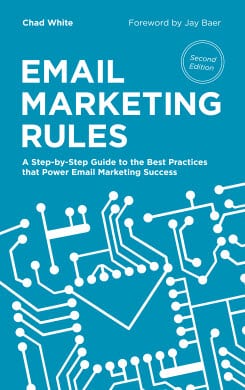Exclusive excerpts from Chad White's new book
 You don't have to be...ahem...nearing 50 to struggle to keep up with all the changes in digital marketing. (In fact, life becomes a lot more relaxed once you accept you can't.)
You don't have to be...ahem...nearing 50 to struggle to keep up with all the changes in digital marketing. (In fact, life becomes a lot more relaxed once you accept you can't.)
It's why guidelines, frameworks and similar play an important role in ensuring your marketing is based on solid foundations.
For email marketers, Chad White provides those foundations in the 120 best practices contained within the 2nd edition of his "Email Marketing Rules" book. The new edition also has additional chapters explaining the interactions and synergies between these best practices.
Obviously some of those rules cover basics like "Don't buy email lists", but Chad kindly allowed me to pull out other rules that many marketers neglect in the rush to write the next subject line.
1. "Focus on maximizing the value of a subscriber, not on maximizing the results of a campaign."
Of course you should look to optimise the results of each individual email, but Chad's point here is to think of results across the long-term.
Short-term campaign-by-campaign thinking can lead to diminishing returns as a list is pounded mercilessly in search of quick-hit clicks and sales.
A longer-term view frees you to include relationship-building messages that "keep subscribers engaged and primed to convert in the future".
It also prevents you using the kind of tactics that might give the current campaign a little boost, but at the expense of future campaigns. An obvious example is a deceptive email subject line that gets more attention, but trains people to mistrust (and ignore) future emails.
Chad suggests you explore metrics like subscriber lifetime value and open (click/conversion) reach in addition to the usual email campaign statistics.
2. "When profiling subscribers, ask them questions that lead you to a clear response."
This sounds self-evident, but revisit your sign-up pages, unsubscribe pages or email surveys to check whether a ticked box really tells you what you think it tells you.
As Chad notes, "...if you want to know if a subscriber is interested in men's or women's apparel, ask them that. Don't ask their gender and assume that men are only interested in buying clothes for themselves."
Here's another example I've seen: if an (ex-) recipient ticks "The content is no longer relevant" feedback option on the unsubscribe page, what can you do with that answer? You don't know if your content got worse or if the recipient's interests simply changed.
Paying more attention to the words you use is never a mistake.
3. "Recognize that not all subscribers are equally valuable or desirable."
Chad adds, "Tracking the performance of your subscribers by their acquisition source will allow you to see how each is performing and make decisions about which sources to continue, improve, or abandon."
This is especially critical when higher costs are involved, such as with list rental, co-registration and similar. But, again, avoid leaping to conclusions.
If a particular paid acquisition source produces subscribers that open, click and spend less than the average (and unsubscribe more), the economics might suggest you abandon it.
Take a closer look first - subscriber performance depends (of course) on the basic "quality" of the source. But it also depends on how you "sell" the sign-up. If your form raises false expectations or is unclear about the nature of your emails, then the fault may be with your sign-up copy, not the location.
4. "Message new subscribers differently depending on their acquisition source and customer history."
This rule builds on the previous one. Since not all new subscribers are the same, can you adjust welcome mails to better fit different sources and customer types?
For example, welcome messages introducing your company may be superfluous when long-time customers sign up for emails during an online transaction, but not for those trade show sign-ups.
Chad says, "Tailor your onboarding messaging to the individual subscriber based on what you know about them and what you know about other subscribers who opted in via the same acquisition source."
5. "Make your opt-in forms, welcome emails, and other email marketing components seasonally relevant."
Finally, here's one to remember as Christmas approaches. If you accept that adding seasonal design elements and content boosts responses in campaign emails, then why not apply the same logic to other elements of your email programme? For example, your "...opt-in forms, welcome emails, transactional emails, preference center, and unsubscribe page".
A retailer's welcome mail pre-Christmas might include information about shipping deadlines and gift sections. Since these other elements are not one-off mails, don't forget to switch the messaging back once the relevant season is past, though!
Author's note: Thanks to Chad White for permission to reprint excerpts from his book, which (disclaimer!) I also worked on in a minor editorial capacity.



 You don't have to be...ahem...nearing 50 to struggle to keep up with all the changes in digital marketing. (In fact, life becomes a lot more relaxed once you accept you can't.)
You don't have to be...ahem...nearing 50 to struggle to keep up with all the changes in digital marketing. (In fact, life becomes a lot more relaxed once you accept you can't.)


